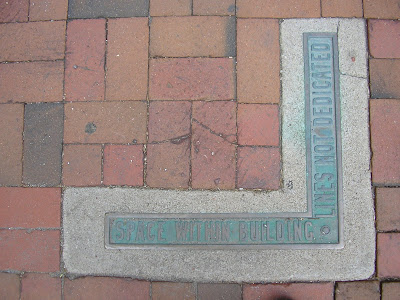Below are some photos of a series of five weirs that I helped build about four years ago. The weirs were built in a city drainage ditch that bisects a four acre garden that I was helping develop. The water flowing through this ditch consists of stormwater from surrounding neighborhoods. We had previously reshaped portions of the ditch, creating a pond before the ditch left the property. Water from this pond is then used to supply various water features throughout the garden.
The weirs were built for several reasons. One, we were trying to reduce sedimentation within the pond. The five weirs provide stilling points where the sediments can fall out. Two, we were attempting to control the erosion taking place during frequent flash floods. Three, we were creating a cool water feature. Water is pumped from the pond via a 3" pipe to the point where the ditch enters the property, creating a constant, recirculating flow of water in what you could now call a creek. The flat surfaces of water, only interrupted on the low side of each weir, appear as a jagged mirror cutting through the property.
All weirs were constructed entirely from recycled materials. In fact, all of the bricks, concrete blocks, roofing tiles, etc came from the ditch itself. Apparently some previous visionary had decided to fill some low land along the banks of this ditch with construction debris. After flash floods, bricks could be seen strewn along the banks of the ditch. We simply picked them up and stashed them in a pile. That pile grew quite large. Any time we were working in the vicinity of the ditch (planting trees, etc) we would find bricks to add to the pile. The only elements of these weirs that did not come from the property itself are the concrete footings that we poured beneath each. Even the rebar that we used came from broken slabs of concrete that we removed from another portion of the property.
 Just below the bridge (I built that too), is the last, and smallest, in the series of five weirs. When this weir doesn't have debris piled up behind it, a very thin sheet of water pours over its entire width. This is where the ditch begins widening into a pond.
Just below the bridge (I built that too), is the last, and smallest, in the series of five weirs. When this weir doesn't have debris piled up behind it, a very thin sheet of water pours over its entire width. This is where the ditch begins widening into a pond.
Pumps push the water to the head of the ditch to allow a constant flow through the system of weirs. Things get more exciting when it rains. During periods of drought, this system doesn't continue to operate. No potable water is used.

We purposefully left many nooks and crannies in the weirs in order to plant plants and to allow others to colonize their surfaces. What you see here is
Acorus graminueus, also called Sweet Flag. Other weirs have ferns and other moisture loving plants growing from their surfaces.

It doesn't take long before mosses are colonizing the moist surfaces.


These are truly bric(k)olage weirs. The use of materials looks a bit crazy, I'll admit. We wanted these to appear to have been built out of necessity by someone using whatever they had on hand. So that's what we did. Not only bricks, but roofing tiles, chimney tiles, concrete rubble, pavers, etc were used...whatever we had found in the ditch itself. The boulders that you see in the ditch near the weirs came from a house about a block away that was being demolished.





























